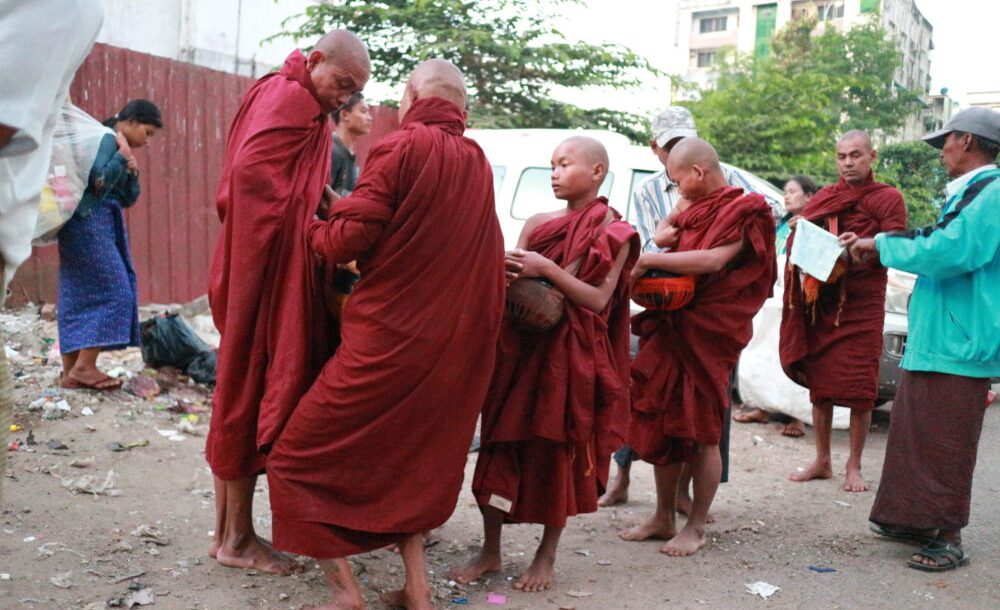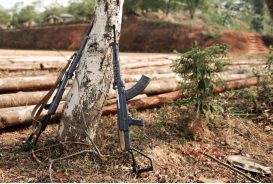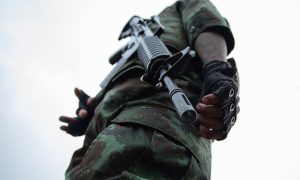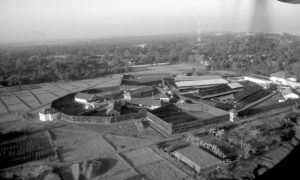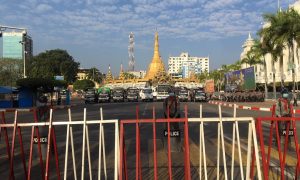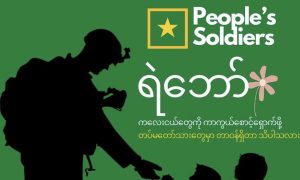This post is an abridged version of an article that appears in a special edition of the Journal of Contemporary Asia on “Revolution and Solidarity in Myanmar” (Vol 54 No 5).
Not surprisingly, revolutionary visions pose serious threats to institutionalised religion, such as the Sangha—the monastic order—in Myanmar. From a Buddhist–normative point of view, the question inevitably arises as to what extent a revolution constitutes a threat to the sasana (Buddhism). How do Myanmar’s nearly 600,000 monks and nuns relate to the groundbreaking work at stake? Do they see the revolution as a threat to Buddhism? Or do they see the military as a threat to Buddhism?
During 2007’s so-called “Saffron Revolution”, resistance was articulated within a Buddhist framework—for example, by monks chanting Buddhist protective prayers in public space; inversion of the alms-bowl as a form of religious boycott of military personnel; and with monastic gatherings at politically important Buddhist sites such as the Sule Pagoda and the Shwedagon Pagoda in Yangon. If it is true that what distinguishes the post-2021 coup political struggle from previous struggles is a shift from a Buddhist political paradigm that includes notions about close state–Sangha relations and royal protection of Buddhism, to a notion of the sovereignty of the people—articulated in a progressive and multi-cultural ethos—then what is the role of Buddhist political paradigms, or of institutional Buddhism, in creating new political orders?
Understanding anti-revolutionary Buddhism
The Theravada Buddhist Sangha in South and Southeast Asia is often spoken of as one unitary body, both in Buddhist traditions themselves, as well as in academic literature. In our research project on Buddhist responses to the Myanmar Spring revolution, we interviewed 30 Buddhist monks and lay people, in addition to analysing digital materials. Based on our empirical findings, we question that narrative by pointing out that the Sangha in revolutionary Myanmar is a divided and multifaceted phenomenon. Our research shows three important aspects of military–monastic relations after the 2021 military coup: the Military–Monastic Complex, the Buddhist Ideology of Order, and finally, Buddhist Revolutionary Monks.
First, our research demonstrates how the military, through a long-term project called the saya-dakar program, has been successful in co-opting parts of the Sangha in what we call the Military–Monastic Complex. This project, which was initiated after the massive military crackdown in 1988, has served as a state propaganda tool to tie together the junta and the most senior monks in every township across the country through various forms of support such as funding of monastic educational programs, access to land, or lavish temple donations.
Within three decades, the junta managed to tame hundreds of progressive and pro-democracy monks and suppress dissent with help from its pro-military network backed by the project. This fits precisely with what Benjamin Schonthal and Tom Ginsburg in an important article on state–Sangha relations in the region have termed “Sangha capture”.
However, this instrumentalist explanation alone is not sufficient for explaining monastic support to the military. A second finding in our research is that we need to understand the strong monastic ideological commitment to the military in the revolutionary situation. As we have shown in a previous article, the initial response from many leading monks was condemnation of the coup.
Importantly, however, with the military crackdown on civilians and subsequent armed popular resistance, monastic elites increasingly favoured what we define as a Buddhist Ideology of Order. The roots of the Buddhist Ideology of Order, which is crucial to the Military–Monastic Complex described above, can be traced to two distinct, but interrelated, strands of thought.
The first strand is rooted in Buddhism itself, for example, in Buddhist fears of chaos and anarchy, as depicted in canonical texts such as the Agañña sutta. Furthermore, it can be argued that a focus on order and discipline is inherent to the Sangha itself (as expressed in the Monastic Code, the vinaya). The second is linked to the post-1988 military ideology of law and order. The political concept of law and order corresponds to the absence of anarchy, the latter understood as a condition of being kingless. What we see is that the military law-and-order narrative can easily be combined with Buddhist fears of anarchy as well as monastic notions of discipline.
Within the Sangha, a minority of monks openly engages in the military’s anti-revolutionary operations. For example, the Shan monk Wazibeik Sayadaw, who has long-term ritual relations with General Min Aung Hlaing and his wife Kyu Kyu Hla, made headlines for his magic services (yadaya) to the army. He became particularly unpopular among revolutionaries for making a magical utterance calling for violence, saying to army soldiers that, “If you want a new age, you better make headshots”. Other monks, such as Ashin Warthawa and Ashin Nandacara, have delivered sermons where they encourage villagers to join the junta-aligned Pyu-Saw-Htee paramilitary troops in their fight against the revolutionaries.
When analysing their online sermons and postings on social media, we see that these anti-revolutionary monks are particularly informed by the anarchy narrative, in which the People’s Defence Forces (PDFs) are portrayed as anti-Buddhist. The extension of the enemy narrative to the Bamar Buddhist majority indicates a noteworthy narrative shift: the enemy is now not only racialised, non-Buddhist Others (such as the Rohingya) but also defined, internal enemies of Buddhism. This implies de-humanisation of the internal enemy, thus laying the ground for acts of violence against the majority population.
Ethnonationalism and Myanmar’s future
Framing the war in Myanmar as a ‘fight for democracy’ obscures the crisis of the nation-state at the conflict’s heart
Buddhist Revolutionary Monks
Analysts have so far been overwhelmingly concerned with monastic support for the military—perhaps informed by the massive lay revolutionary critique of the Sangha, but also informed by the notion that the Sangha should take a moral lead against injustice. This general surprise as well as disappointment, we think, has led to a gap in our knowledge about the multitude of responses to the coup, as well as to the ongoing revolution. Our research shows that within the Sangha there is a radical minority who actively work for the revolution and see themselves as “Buddhist revolutionaries”.
Perhaps the most significant monk in the monastic revolutionary movement and leader of the Spring Revolution Sangha Network is the Mon Buddhist monk known as King Zero. In the Burmese language this is min thoun nya, which means “King of Emptiness”. The name is a direct reference to the Burmese tradition of kicking back at political power and is therefore in itself deeply revolutionary. To him, being a revolutionary is to restore the dhamma, meaning that revolution and the dhamma cannot be separated. Decline in dhamma is what caused the suffering of people in the first place. His mission is to build a dhamma state after the revolution. In our conversations with him, he pointed out that in his view, this dhamma state must be “a religiously-inclusive state in which followers of different faiths can coexist peacefully”. A dhamma state is not about creating a religious (batha) state based on religious exclusion of minorities, but one built on respect, peace, and justice, transcending religious and ethnic differences.
Division and polarisation
The implications of our findings are twofold. First, they provide empirical data that questions narratives of full co-option of the Sangha by the military state. While it is true that the military state works relentlessly to control the Sangha, such efforts rely on territorial control. As the military is increasingly losing territorial control, revolutionary monks have fled to the liberated areas.
Second, our study brings to the fore little-known aspects of the revolution, namely monks and nuns who work for the revolution to succeed. What became very clear in our material was the importance of long-term monastic engagements with resistance networks, revealing hidden forms of monastic revolutionary engagements. As clearly demonstrated in our interviews and observations from the field, when popular resistance was met with massive violence in March 2021, monastic resistance to the coup did not disappear, but underwent a radical transformation.
Admittedly, monastic revolutionary networks represent a radical minority. But monastic resistance needs to be understood as a broader social field beyond defined networks. This includes multiple forms of humanitarian engagement among monks who do not necessarily identify with the clearly defined radical networks, and who might even be concerned about the ways in which the revolution is performed through harsh language or magic practices. As our research highlights, such monks still self-identify as “revolutionary monks” and work tirelessly for the Spring Revolution to succeed, albeit in less linguistically and aesthetically radical ways.
Finally, we argue that the 2021 Spring Revolution calls for an altogether different theorising of the relationship between religion and revolution, calling attention to the ways in which religion (in this case Buddhism) is neither the state-loyal suppressor of revolts (in failed uprisings) nor the victim of anti-religious revolutionary politics. Rather, Buddhism finds itself on multiple sides of the revolutionary situation, including what might be understood as a Buddhist Ideology of Order and revolutionary politics.
 Facebook
Facebook  Twitter
Twitter  Soundcloud
Soundcloud  Youtube
Youtube  Rss
Rss 